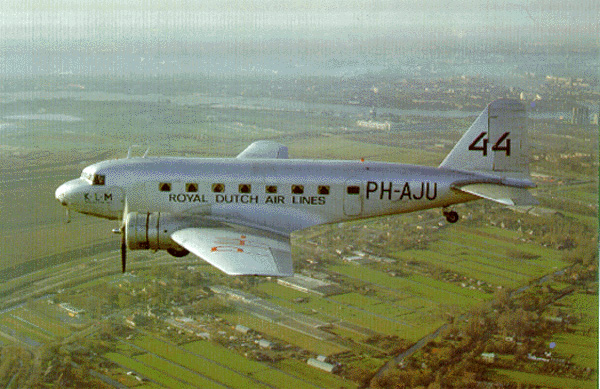The MacRobertson Air Race, 1934
England to Australia

DC-2 "Uiver-2," an exact replica of the original DC-2 "Uiver"
which won the handicap division of the
1934 Great Air Race. PH-AJU is still flying in Holland. Photo courtesy of
the Dutch Dakota Association.
The Great 1934 London to Melbourne Race was sponsored by
the Melbourne confectionary giant, Sir Macpherson Robertson. It was divided
into a speed competition and a handicap division, and was run over an 11,300
mile course. Twenty entrants took part. Eleven finished the course. Three
aircraft crashed, in one case killing both crew. See the last pages for the
entrants and results
Thanks to John Burford, the author of the terrific historic narrative of the
race that follows, for generously granting us permission to repost it. John
has written many other interesting Australian Aviation features, too – Click
on the banner. More about John Burford here.
--------------------------------------------------------------------------------
PRELUDE
 In 1930, the question as to how the Australian state of Victoria, and its
capital city Melbourne, might celebrate its coming centenary produced a
suggestion from Melbourne's Lord Mayor, Harold Smith, that an air race
linking England with Australia be organised. A sponsor was sought, and found
in the person of wealthy confectionary manufacturer, Sir Macpherson
Robertson, of Macrobertson's Chocolates.
In 1930, the question as to how the Australian state of Victoria, and its
capital city Melbourne, might celebrate its coming centenary produced a
suggestion from Melbourne's Lord Mayor, Harold Smith, that an air race
linking England with Australia be organised. A sponsor was sought, and found
in the person of wealthy confectionary manufacturer, Sir Macpherson
Robertson, of Macrobertson's Chocolates.
The Royal Aero Club of England was to oversee the event. It was divided into
a speed division – the winner being the first aircraft to reach Melbourne;
and a handicap division, which allowed 16 days to finish, the winner having
the lowest flying time based on a formula.
Pioneering pilot Jim Mollison flew a route in 1931 between England and
Australia which was adopted as the basis of the race's course. It covered
11,300 miles, and would include five compulsory stops. Pilots could choose
their own course between those stops, and a further 22 optional stops or
"checking points" were included. The Royal Aero Club set to work convincing
various countries along the way to upgrade airports chosen for compulsory
stops and checking points, and the Shell Oil and Stanavo companies provided
supplies of fuel and lubricants at all points. If required, entrants could
also enjoy overnight accommodation at the stops.
The rules did not limit aircraft size or power, or crew size. It was
stipulated that no pilot could join an aircraft after it left England. All
had to carry three days rations per crew member, as well as floats, smoke
signals and efficient instruments. Another rule was subsequently added that
entrants would have to produce a certificate of airworthiness from their own
country confirming that the aircraft met the minimum safety requirements of
the International Convention of Air Navigation (ICAN).
This immediately troubled the U.S. entrants, whose Department of Commerce
issued separate certificates for commercial aircraft and long-distance
racing machines, the second of which the Royal Aero Club at first refused to
accept. A compromise was reached in which the U.S. racing certificates were
accepted with a few changes.
The British had no aircraft which stood out as a promising contender until,
early in January 1934, Geoffrey DeHavilland announced his company would be
prepared to build a number of 200 mph aircraft with a range of 3,000 miles
for a comparatively low price, if at least three firm orders were received
by the last day of February. Three orders were placed, for what would become
the DH.88 Comet aircraft, G-ACSP, G-ACSR and G-ACSS.
With a take-off date set of 20th October, 1934 at dawn, it looked like the
race would be a huge event. There were 64 potential starters from 13
countries, the biggest contributor being the United States, - 27 aircraft
and 20 pilots. As the deadline drew near, the field reduced to 20 starters.
Irish entrant Colonel James C. Fitzmaurice was forced to withdraw hours
before the race when his Bellanca, "Irish Swoop", proved to be overweight,
and he was not willing to sacrifice fuel load.
Lloyd's of London gave race participants a 1 in 12 chance of being killed.